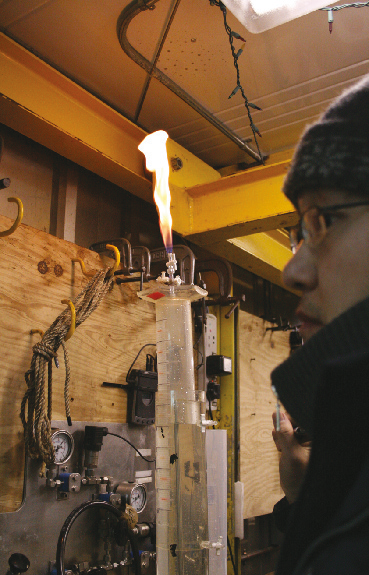Trapped beneath the world’s ocean floors, sealed by low temperatures and high pressure, lies a frozen reservoir of natural gas. These methane hydrates, or icy deposits of methane, contain more organic carbon than all the world’s coal, oil and non-hydrate natural gas combined, according to the U.S. geological Survey.
More importantly, methane hydrates are an equal opportunity energy source, distributed evenly in the sediments beneath ocean and sea floors, and also under the arctic tundra.
But environmental challenges must be overcome, says Tae Sup Yun, before methane hydrates realize their potential.
“When you extract methane hydrates,” says Yun, the P.C. Rossin assistant professor of civil and environmental engineering, “methane begins to dissociate from the sediment in which it is trapped. This dissociation causes the sediment to collapse.”
The shifting sediment can damage marine life and cause marine landslides and even tsunamis, says Yun, who has studied hydrates in the Indian ocean, the gulf of Mexico and the East Sea off Korea’s coast.
Careless hydrate extraction can also lead to global warming, he says.
“Dissociation can also trigger the release of methane, a greenhouse gas, into the atmosphere. This is potentially serious, as the methane in hydrates is very concentrated.”
To harvest methane safely from hydrates, says Yun, engineers must prevent dissociation during recovery.“Because the hydrate is under high pressure and is extremely cold, dissociation sets in and the ice begins to melt as soon as you remove hydrate from sediment,” says Yun. “To preserve the in situ environment of hydrate and sediment, we must recover the material under hydrostatic pressure.”
Yun has helped develop an instrumented pressure Testing Chamber (IPTC), which characterizes the hydrate-bearing sediment under pressure. The IPTC played a key role last year when Yun joined researchers from the Korean institute of geoscience in recovering hydrate-bearing sediment from the East Sea and preserving it in pressurized aluminum chambers. The chambers were aligned with the IPTC, and sensors measured the sediment’s strength, electrical conductivity, and compressional and shear wave velocity.
The sensors, together with x-rays, enabled researchers to identify the white veins of methane hydrate embedded in the sediment. an mRi of the chamber allowed researchers to see the orientations of hydrate seams and determine their thickness.
By enabling researchers to measure the properties of hydrate-bearing sediment under pressure, says Yun, the ipTC will help answer several critical questions. how much methane gas is inside each hydrate? and more importantly, how do the properties of the sediment change as gas is produced from hydrates?
“The driving question,” says Yun, “is why the gas hydrate forms this kind of geometry in the sediment. also, what are the mechanical, thermal and molecular properties of the gas hydrate and sediment?”
It will take a decade or more, Yun estimates, before researchers learn to harvest methane safely from hydrates.
“We need to understand fully how dissociation affects the sediment,” he says. “This is a very complex phenomenon.”

